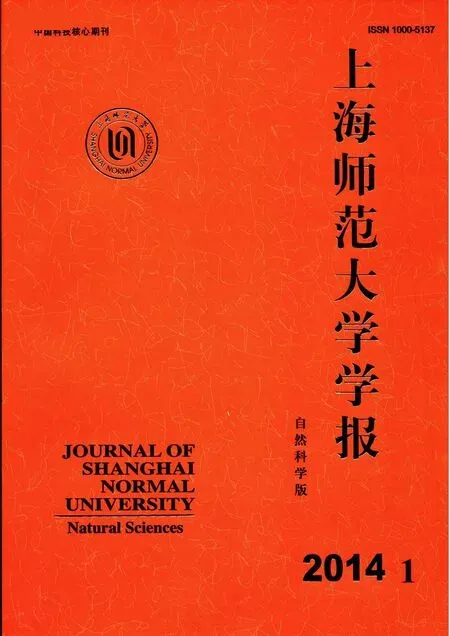Stability criteria for delay differential-algebraic equations
2014-03-20LIULinglingFANNiSUNLeping
LIU Lingling, FAN Ni, SUN Leping
(College of Mathematics and Sciences,Shanghai Normal University,Shanghai 200234,China)
1 Introduction

f(s)=f(x,y)=u(x,y)+iv(x,y)
(1)

Theorem1.1[1]If for any(x,y)∈∂W,the real partu(x,y)in (1)does not vanish,thenf(x,y)≠0 for any(x,y)∈W.

Theorem 1.2 is an extension of Theorem 1.1.
2 Delay independent stability of DDAEs
Now we deal with the asymptotic stability of DDAEs,
Ax′(t)=Bx(t)+Cx(t-τ),
(2)
whereA,B,C∈d×dare constant real matrices,Ais singular andτ>0 stands for a constant delay.For the stability of the system(2),we investigate its characteristic equation
det[λA-B-Ce-λτ]=0.
(3)

(4)

(5)
then(3)may be written as
(6)
wherez=x+iy.By the above assumption that Res<0⟺Reλ<0 is valid.
The following two lemma are well-known.
Lemma2.1[2]If the real parts of all the characteristic roots of(5)are less than zero,then the system(2)is asymptotically stable; That is,the solutionx(t)of (2)satisfiesx(t)→0 ast→∞.
Lemma2.2[3]LetA∈d×dandB∈d×d.If the inequality |A|≤Bholds,then the inequalityρ(A)≤ρ(B)is valid.Here the order relation of matrices of the same dimensions should be interpreted componentwise.|A| stands for the matrix whose component is replaced by the modulus of the corresponding component ofA,andρ(A)means the spectral radius ofA.
For a complex matrixW,letμ(W)be the logarithmic norm ofW.

Lemma2.3[3]For each eigenvalue of a matrixW∈d×d,the inequality
-μp(-W)≤Reλi(W)≤μp(W)
holds.
Lemma2.4[4]LetU,Vben-by-krectangular matrices withk≤nandAbe ann-by-nmatrix.Then
T=I+VTA-1U
is nonsingular if and only ifA+UVTis nonsingular.In this case,we have
(A+UVT)-1=A-1-A-1UT-1VTA-1.

The following lemma states a sufficient condition for the stability of (2).

(7)
holds,the system (2)is asymptotically stable.

Applying the properties of the logarithmic norm,Lemma 2.4 and Lemma 2.5,we have
This,however,contradicts the condition.Hence the proof is completed.
The following theorem gives a region including all the roots of (5)with nonnegative real parts when the condition of Lemma 2.6 fails.

(i) If we have the estimation
then the inequalities
and
hold.
(ii) If we have the estimation
define a positive numberβsatisfying
Then the inequalities
and
Proof(i) A discussion similar to that of Lemma 2.6 yields
Next,the imaginary part of an eigenvalue of a matrixAB-1is equal to the real part of an eigenvalue of -iAB-1.The second inequality holds.
(ii) By Lemma(2.3)
(8)
A derivation similar to that in (i) leads to
(9)

Here the truth of the last inequality is attained form the following.

Hence,taking (9)into consideration,we have
Iteration
and the monotonicity
ensure that the limit of the series {βj} is equal toβ,whereβis a positive number satisfying
Therefore the first inequality holds.In a similar manner we can get the second inequality.

|s|≤ρ(|A|·|B-1|·(I-|CB-1|)-1)
holds.
ProofBy the assumption above,there exists an integerj(1≤j≤d)such that
This implies the inequality
It is obvious that

Due to Lemma 2.2,we have the conclusion.
3 Delay-dependent stability of DDAEs:boundary criteria
Let
By virtue of Lemma 2.6,ifγ<0,the system(2)is Delay-independent asymptotically stable.Ifγ≥0,the system (2)may be stable or unstable.We consider the stability of (2)whenγ≥0.

(i) Ifβ0≤0,then we put
(ii) Ifβ0>0,then we put
whereβis a root of the equation
Under the above notation we turn our attention to the following three kinds of bounded regions in thes-plane.
Definition1Letl1,l2,l3andl4denote the segments {(E0,y):F0≤y≤F},{(x,F):E0≤x≤E},{(E,y):F0≤y≤F} and {(x,F0):E0≤x≤E},respectively.Furthermore,l=l1∪l2∪l3∪l4and letDbe the rectangular region surrounded byl.
Definition2LetR=ρ(|A|·|B-1|·(I-|CB-1|)-1).LetKdenote the circular region with radiusRcentered at the origin of the plane ofC.
K={(r,θ):r≤R,0≤θ≤2π}.

A necessary and sufficient condition for the delay-independent stability of the system(2)is presented in [5].The following two theorems give criteria for the delay-dependent stability of the system(2).We apply Theorem 1.1 and Theorem 1.2 to prove them respectively.
Theorem3.1If for any (x,y)∈∂T,the real partU(x,y)in(6)does not vanish,then the system (2)is asymptotically stable.


Due to Theorem 2,we can further extend the above result as follows.
Theorem3.2Assume that for any (x,y)∈∂T,there exists a real constantλsatisfying
U(x,y)+λV(x,y)≠0.
Then the system (2)is asymptotically stable.
The proof is analogous to Theorem 3.1.
We give two criteria for the delay-dependent stability of the linear delay system(2).Theorem 2.1 and Theorem 2.2 show that the unstable characteristic roots of the system (2)are located in some specified bounded region in the complex plane,while Theorem 3.1 and Theorem 3.2 show that it is sufficient to check certain conditions on its boundary to exclude the possibility of such roots from the region.Theorem 1.1 and Theorem 1.2 provide general and simple criteria for the nonexistence of zeros of an analytic function in any boundary region.
:
[1] HU G D.Stability of discrete-delay systems:boundary criteria[J].Applied Mathematics and Computation,1996,80:95-104.
[2] KUANG J X,TIAN H J.The asymptotic behaviour of theoretical and numerical solution for the differential equations with several delay terms[J].Journal of Shanghai Normal University:Natural Sciences,1994,23(Math Supl):1-9.
[3] DESOER C A,VIDYASAGAR M.Feedback system:input-output properties[M].New York:Academic Press,1997.
[4] GOLUB G,VAN LOAN C F.Matrix computations[M].3rd edition.Baltimore:Johns Hopkins University Press,1996.
[5] QIU L,KUANG J X.On the LD-stability of the Nonlinear Systems in MDBMs[J].Journal of Shanghai Normal University:Natural Sciences,1996,25(4):6-11.
[6] HU G D,MITSUI T.Stability of Linear Systems with Matrices Having Common Eigenvectors[J].Japan J Indust Appl Math,1996,13:487-494.
[7] LU L H.Numerical stability of theθ-methods for systems of differential equations with serveral delay terms[J].Journal of Computational and Applied Mathematics,1991.34:292-304.
[8] SUN L P.ThePm-stability of multistep runge-kutta methods for delay differential equations[J].Journal of Shanghai Normal University:Natural Sciences,1997,26(4):17-22.
杂志排行
上海师范大学学报·自然科学版的其它文章
- A three-dimensional tetrahedral-shaped conjugated small molecule for organic solar cells
- Critical behaviors of gravity under quantum perturbations
- 上海地区杂草稻与水稻籽实形态差异比较研究
- The research on natural gas pipeline transportation price formulation method
- Regularization of Casimir free energy for p-dimensional Hypercubic Cavities inside D+1-dimensional Minkowski Spacetime
- Critical behaviors of gravity under quantum perturbations
